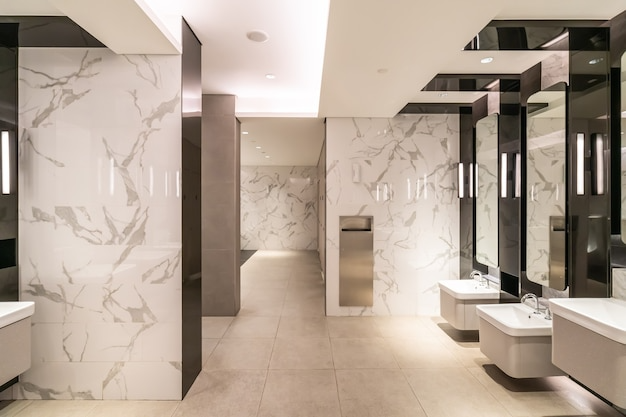
Terrazzo tile, a composite material known for its unique beauty and durability, has made a remarkable comeback in the realm of contemporary interior design.
This flooring material, which dates back to ancient times, has evolved from its traditional usage to become a staple in modern aesthetics.
Once a symbol of opulence in grand Italian palazzos, terrazzo has transitioned into a versatile choice for today’s homes and commercial spaces.
Its resurgence in popularity is not just a nod to its historical significance, but also an acknowledgment of its adaptability in various design contexts.
This article delves into the versatility of terrazzo tile, exploring how it has been reimagined in contemporary settings, influencing trends, and offering a unique blend of functionality and style in the ever-evolving world of interior design.
Understanding Terrazzo Tile
Terrazzo tile, a composite material made from chips of marble, quartz, granite, or glass, set in cement or epoxy, is renowned for its robust and customizable nature.
Originating in Italy over 500 years ago, terrazzo was initially created as a way to reuse scrap materials.
Today, it stands as a symbol of sustainable and innovative design. The unique characteristics of terrazzo, such as its durability, eco-friendliness, and aesthetic adaptability, make it a favourite among modern architects and designers.
Terrazzo Tile in Modern Interior Design Trends
Terrazzo tile has surged in popularity within contemporary interior design, celebrated for its versatility and unique aesthetic.
This resurgence aligns with current trends that favour sustainable, durable materials with a timeless appeal.
Designers are increasingly drawn to terrazzo for its ability to inject personality into a space through its myriad of colours and patterns.
In residential settings, terrazzo is often used to create statement floors that become the centrepiece of a room.
Its ability to blend seamlessly with various architectural styles, from minimalist to eclectic, makes it a preferred choice for homeowners seeking a balance between functionality and aesthetic appeal.
Commercially, terrazzo has become a symbol of sophistication in hotels, offices, and public buildings.
Its durability makes it ideal for high-traffic areas, while its sleek appearance aligns with corporate aesthetics.
Public spaces like airports and museums utilize terrazzo for its ease of maintenance and the grandeur it lends to large, open spaces.
The trend extends beyond traditional applications. Designers are now using terrazzo in unexpected ways, such as in wall treatments, kitchen countertops, and even furniture, showcasing its versatility as a material not just for floors but as a comprehensive design element.
The diverse range of colours and textures available in terrazzo tile allows it to adapt to various colour schemes and design concepts.
Whether it’s acting as a neutral backdrop or a vibrant focal point, terrazzo’s ability to harmonize with different styles is a key factor in its growing popularity in modern interior design.
This adaptability ensures that terrazzo tile remains not just a passing trend but a lasting element in contemporary design landscapes.
Creative Applications of Terrazzo Tile
Terrazzo tile offers an expansive canvas for creativity in interior design, far beyond its conventional use in flooring.
This section explores the innovative ways in which terrazzo is being utilized in contemporary spaces, demonstrating its versatility and aesthetic range.
Floors:
Terrazzo is traditionally associated with flooring, and contemporary designs have pushed this association to new heights.
Designers are experimenting with bold patterns, integrating various colours to create intricate mosaics or large, geometric designs.
This versatility allows terrazzo floors to either stand out as a statement piece or blend subtly with the overall design theme.
Walls and Backsplashes:
Moving up from the floor, terrazzo is now a popular choice for walls and backsplashes.
It adds texture and visual interest to kitchen backsplashes, bathroom walls, or as accent walls in living areas.
The material’s durability and ease of cleaning make it practical, while its aesthetic qualities add a touch of sophistication.
Furniture and Accessories:
The use of terrazzo in furniture and home accessories is a testament to its versatility.
Designers are crafting tables, countertops, lamp bases, and even decorative objects like vases and coasters.
These pieces become unique art installations in themselves, each with a distinct terrazzo pattern.
The creative applications of terrazzo tile in contemporary interior design are vast and varied.
Its ability to be moulded into various forms and incorporate a wide range of colours and textures allows designers to push the boundaries of traditional interior design, making terrazzo a material that not only respects its historical roots but also embraces modern innovation.
Combining Terrazzo with Other Materials
The versatility of terrazzo tile is further enhanced when it is paired with other materials in interior design.
This synergy can create a balance of textures and add depth to any space.
In this section, we explore effective combinations of terrazzo with various materials, providing insights and ideas for harmonious interior design.
- The warmth of wood contrasts beautifully with the cool, smooth surface of terrazzo. In a room with a terrazzo floor, wooden furniture or wooden accents can add a natural, organic feel. This combination works well in both modern and rustic settings, offering a balance between nature and craftsmanship.
- Terrazzo and metal are a match made in contemporary design heaven. The use of metallic finishes, like brass or copper, with terrazzo creates a sophisticated, luxurious look. This combination is perfect for spaces aiming for a sleek, modern aesthetic. Metal fixtures or furniture in a room with terrazzo flooring or walls can add a refined touch.
- The translucency of glass complements the dense, opaque nature of terrazzo. A glass-topped table on a terrazzo floor, or glass vases and bowls placed on terrazzo surfaces, can create an elegant, light, and airy feel. This combination is ideal for creating an open, minimalist space.
- Integrating terrazzo with other materials requires a thoughtful balance of textures and colours. A key tip is to use terrazzo as the focal point and select other materials that complement rather than compete with it. Neutral-coloured terrazzo can be paired with bold textures, while vibrant terrazzo patterns might be best balanced with subtle, monochromatic materials.
The combination of terrazzo with other materials opens up a world of design possibilities. Whether aiming for contrast or cohesion, the interplay of textures and colours can elevate the aesthetic of any space.
Maintenance and Longevity of Terrazzo Tile
Terrazzo tile is renowned for its longevity and ease of maintenance, making it a practical choice for both residential and commercial spaces.
To maintain its lustre, regular sweeping and mopping with a pH-neutral cleaner are recommended.
Avoid harsh chemicals, as they can etch the surface.
For cement-based terrazzo, periodic sealing is advised to prevent stains and facilitate cleaning.
Terrazzo’s durability is one of its greatest assets; it resists wear and tear remarkably well, making it ideal for high-traffic areas.
With proper care, terrazzo can retain its beauty and functionality for decades, proving to be a cost-effective and sustainable flooring option.
Future of Terrazzo in Interior Design
The future of terrazzo in interior design looks promising, driven by its versatility, sustainability, and aesthetic appeal.
Industry experts predict a continued rise in its popularity, not just as flooring but in more innovative applications.
Advancements in technology are enabling more intricate designs and colour variations, making terrazzo more adaptable to contemporary design trends.
Additionally, the focus on sustainable and eco-friendly materials in construction and design bolsters terrazzo’s appeal, as it often incorporates recycled materials.
The potential for customization and its timeless elegance positions terrazzo as a material that can transcend passing fads.
As we move forward, terrazzo is poised to be not just a feature of design, but a defining element of modern, conscious, and creative architectural expressions.
Conclusion
The exploration of terrazzo tile in contemporary interior design reveals its remarkable transformation from a traditional flooring material to a versatile design element.
Its durability, ease of maintenance, and potential for customization make it a sought-after choice for both residential and commercial spaces.
The creative applications of terrazzo, from floors and walls to furniture and accessories, showcase its ability to adapt to various styles and preferences.
As we look towards future trends in interior design, terrazzo stands out as a material that combines aesthetic appeal with practicality, sustainability, and a timeless charm, ensuring its place in the annals of design for years to come.





